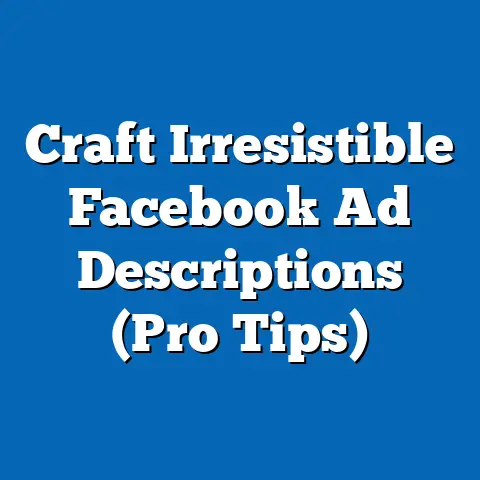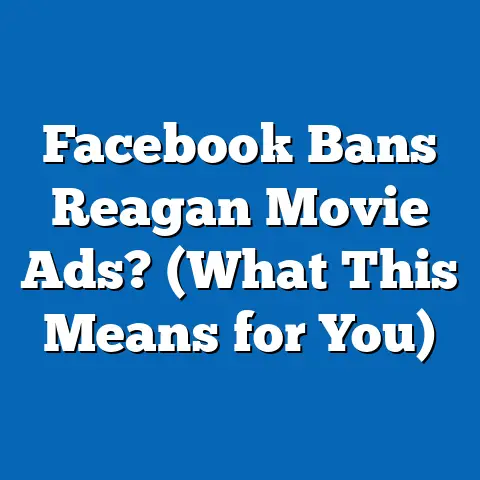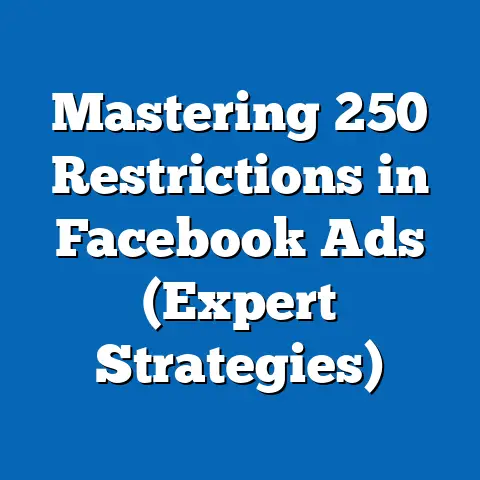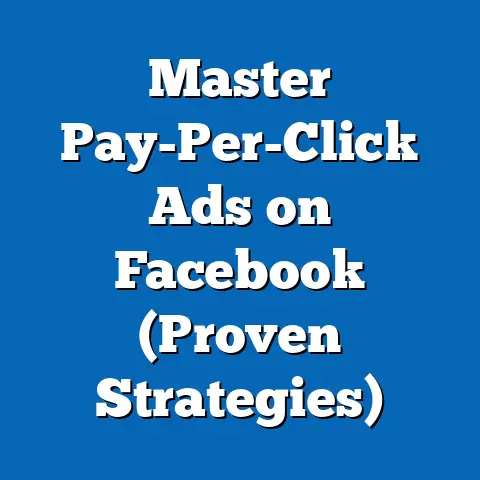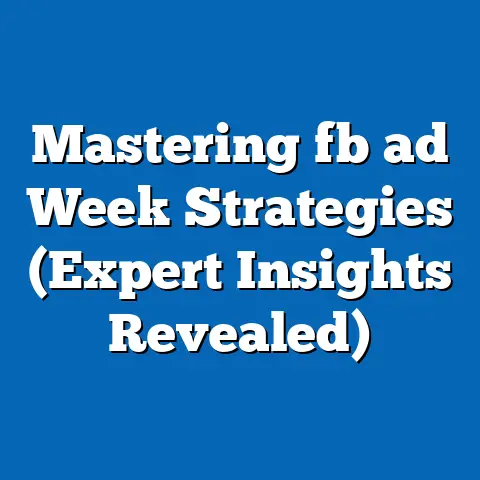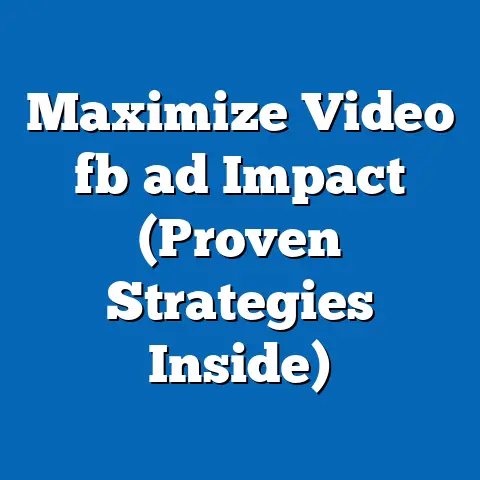Mastering Monthly Facebook Ad Costs (Game-Changing Insights)
Facebook advertising is a powerhouse, I truly believe it. It’s not just about throwing money at ads and hoping for the best. It’s a dynamic, customizable platform where you can tailor your strategies to perfectly align with your unique business goals, identify and engage your ideal target audience, and, most importantly, manage your budget effectively. I’ve seen firsthand how businesses, big and small, have transformed their marketing efforts through strategic Facebook ad campaigns.
The real game-changer? Understanding and mastering your monthly ad costs. It’s not just about being frugal; it’s about maximizing your return on investment (ROI). Think of it as fine-tuning an engine for peak performance. This article isn’t just a guide; it’s a roadmap to help you navigate the often-complex world of Facebook advertising costs. I’m going to share insightful strategies and practical tips that I’ve learned over the years, so you can manage, optimize, and ultimately dominate your monthly Facebook ad expenditures. Let’s dive in!
Understanding the Basics of Facebook Ad Costs
Before we get into the nitty-gritty, let’s lay the foundation. Understanding the fundamentals of Facebook ad costs is crucial for anyone looking to make a serious impact on the platform.
How Facebook Ad Costs are Structured
Facebook ad costs aren’t just random numbers. They’re based on a bidding system, and understanding this system is key to controlling your spending. Here’s a breakdown of the most common bidding strategies:
- Cost Per Click (CPC): You pay each time someone clicks on your ad. This is great for driving traffic to your website or landing page. I’ve found CPC to be particularly effective when I’m focused on generating leads or driving direct sales.
- Cost Per Mille (CPM): You pay for every 1,000 impressions your ad receives. Impressions are the number of times your ad is displayed, regardless of whether someone clicks on it. CPM is often used for brand awareness campaigns, where the goal is to get your message in front of as many people as possible.
- Cost Per Action (CPA): You pay when a specific action is taken, such as a purchase, a form submission, or an app install. CPA is ideal when you have a clear conversion goal in mind.
Facebook uses an auction system. Your bid competes with other advertisers targeting the same audience. The higher your bid, the more likely your ad is to be shown. However, it’s not just about having the highest bid. Facebook also considers the quality and relevance of your ad, which brings us to the next point.
Factors Influencing Ad Costs
Several factors influence how much you end up paying for your Facebook ads. Understanding these factors allows you to optimize your campaigns and reduce your costs:
- Audience Targeting: The more specific your audience, the higher the potential cost. Highly targeted audiences are often smaller, leading to more competition among advertisers. I once worked on a campaign targeting a very niche demographic, and the CPC was significantly higher than a campaign targeting a broader audience.
- Ad Placement: Where your ad appears on Facebook (e.g., news feed, right column, Instagram) affects the cost. Placements with higher visibility, like the news feed, tend to be more expensive.
- Ad Quality and Relevance: Facebook rewards ads that are engaging and relevant to the target audience. Ads with high engagement rates (likes, comments, shares) and positive feedback tend to have lower costs.
- Competition: The more advertisers targeting the same audience, the higher the competition and the higher the costs. This is especially true during peak seasons like holidays.
- Bidding Strategy: Your choice of bidding strategy (CPC, CPM, CPA) directly impacts your costs. It’s essential to choose the right strategy based on your campaign goals.
Setting a Budget and Its Impact
Setting a budget is paramount. It’s like setting a speed limit on a highway – it keeps you from going too fast and crashing. Your budget directly affects your ad performance in several ways:
- Reach: A higher budget allows you to reach a larger audience.
- Frequency: A higher budget allows you to show your ad more frequently to the same audience, which can increase brand recall.
- Data Collection: A higher budget allows you to collect more data, which you can then use to optimize your campaigns.
You can set either a daily budget or a lifetime budget. A daily budget is the average amount you’re willing to spend each day, while a lifetime budget is the total amount you’re willing to spend over the entire duration of your campaign.
Average Costs for Various Ad Formats
Understanding the average costs associated with different ad formats can help you make informed decisions about which formats to use. According to recent industry data:
- Carousel Ads: Carousel ads, which allow you to showcase multiple products or features, tend to have a slightly lower CPC than single-image ads. I’ve personally found them to be highly effective for e-commerce businesses.
- Video Ads: Video ads often have a higher CPM but can also have a higher engagement rate. If your goal is to capture attention and tell a story, video ads can be worth the investment.
- Story Ads: Story ads are displayed in the Stories section of Facebook and Instagram. They’re typically less expensive than news feed ads but can still be highly effective, especially for reaching younger audiences.
Key Takeaway: Mastering the basics of Facebook ad costs involves understanding bidding strategies, identifying the factors that influence costs, setting a budget, and being aware of average costs for different ad formats. This knowledge will empower you to make informed decisions and optimize your campaigns for maximum ROI.
Now what? This is where the real magic happens. Analyzing your monthly ad spend is like being a detective, piecing together clues to uncover hidden insights and opportunities.Tracking and Analyzing Monthly Ad Spend
Tracking your monthly ad spend is the first step. You can’t improve what you don’t measure. Here are some methods and tools you can use:
- Facebook Ads Manager: This is your primary tool for tracking and analyzing your ad spend. It provides a wealth of data, including impressions, clicks, conversions, and costs.
- Spreadsheets: For more detailed analysis, you can export data from Ads Manager and import it into a spreadsheet. This allows you to create custom reports and visualizations. I often use spreadsheets to track trends over time and identify patterns that aren’t immediately apparent in Ads Manager.
- Third-Party Analytics Tools: There are numerous third-party tools available that integrate with Facebook Ads Manager and provide advanced analytics capabilities. These tools can help you automate reporting, identify opportunities for optimization, and track your ROI more effectively.
Significance of CPC and CPM Analysis
Analyzing your CPC and CPM is crucial for gauging the effectiveness of your ads. Here’s why:
- CPC: A high CPC could indicate that your ad copy or targeting is not resonating with your audience. It could also mean that your landing page is not optimized for conversions.
- CPM: A high CPM could indicate that your audience is too broad or that your ad is not engaging enough. It could also mean that you’re targeting an audience that is highly competitive.
I remember one campaign where the CPC was through the roof. After digging into the data, I realized that the ad copy was confusing and didn’t clearly communicate the value proposition. By rewriting the ad copy and making it more concise and compelling, I was able to reduce the CPC by over 50%.
Utilizing Facebook Ads Manager for Performance Review
Facebook Ads Manager is your command center. Learn to navigate it like a pro. Here’s how to use it to review your campaign performance and identify spending patterns:
- Customize Columns: Choose the metrics that are most important to you and add them as columns in Ads Manager. This allows you to quickly see the data you need without having to dig through reports.
- Use Filters: Use filters to segment your data and identify trends. For example, you can filter by age, gender, location, or ad placement.
- Create Reports: Create custom reports to track your progress over time. You can also schedule reports to be automatically emailed to you on a regular basis.
Aligning Ad Spend with Business Objectives
The ultimate goal is to ensure that your ad spend aligns with your business objectives. Are you trying to generate leads, drive sales, or increase brand awareness? Your ad spend should be allocated accordingly.
- Set Clear Goals: Before launching a campaign, define your goals and how you will measure success.
- Track Conversions: Track your conversions to see how many leads or sales you’re generating from your ads.
- Calculate ROI: Calculate your ROI to see how much revenue you’re generating for every dollar you spend on ads.
Key Takeaway: Analyzing your monthly ad spend involves tracking your expenses, analyzing key metrics like CPC and CPM, utilizing Facebook Ads Manager for performance review, and ensuring that your ad spend aligns with your business objectives. This analytical approach will enable you to make data-driven decisions and optimize your campaigns for maximum impact.
Strategies for Optimizing Facebook Ad Costs
Now that you’ve got a handle on the basics and you’re analyzing your data like a seasoned pro, it’s time to dive into the strategies that will help you optimize your Facebook ad costs. This is where you can really start to see a difference in your ROI.
Audience Segmentation and Retargeting
Audience segmentation and retargeting are two of the most powerful tools in your Facebook advertising arsenal. They allow you to target your ads to specific groups of people based on their interests, behaviors, and demographics.
- Audience Segmentation: Divide your audience into smaller, more targeted groups. This allows you to create ads that are more relevant to each group, which can increase engagement and reduce costs.
- Retargeting: Target people who have already interacted with your business, such as website visitors, email subscribers, or people who have watched your videos. Retargeting is highly effective because these people are already familiar with your brand and are more likely to convert.
I once ran a retargeting campaign for an e-commerce client that targeted people who had added items to their cart but didn’t complete the purchase. By showing them ads with a special discount, we were able to recover a significant number of abandoned carts and increase sales by 20%.
The Role of A/B Testing
A/B testing is the process of testing different versions of your ads to see which one performs best. This is an essential part of optimizing your ad costs.
- Test Different Ad Copy: Try different headlines, body text, and calls to action.
- Test Different Images and Videos: Use different visuals to see which ones resonate most with your audience.
- Test Different Targeting Options: Experiment with different demographics, interests, and behaviors.
I always recommend testing one variable at a time so you can accurately measure the impact of each change.
Leveraging Lookalike Audiences
Lookalike audiences are a powerful way to expand your reach and find new customers who are similar to your existing customers.
- Create a Seed Audience: Start with a seed audience of your best customers or website visitors.
- Let Facebook Do the Work: Facebook will analyze the characteristics of your seed audience and find new people who share those characteristics.
- Target Your Lookalike Audience: Target your lookalike audience with ads that are similar to the ones that have performed well with your seed audience.
Best Times to Run Ads and Adjusting Budgets
Timing is everything. Running your ads at the right time can significantly impact your costs and performance.
- Analyze Your Data: Use Facebook Ads Manager to see when your audience is most active.
- Experiment: Try running your ads at different times of the day and week to see what works best.
- Adjust Your Budgets: Increase your budgets during peak times and decrease them during off-peak times.
Key Takeaway: Optimizing your Facebook ad costs involves segmenting your audience, retargeting potential customers, using A/B testing to refine your ads, leveraging lookalike audiences to expand your reach, and running your ads at the best times while adjusting budgets based on performance data. These strategies will help you maximize your ROI and achieve your business goals.
Advanced Techniques for Reducing Monthly Costs
Ready to take your Facebook advertising game to the next level? These advanced techniques can help you squeeze even more value out of your ad spend and significantly reduce your monthly costs.
Dynamic Ads
Dynamic ads are a game-changer for e-commerce businesses. They automatically show the most relevant products to the right people, based on their browsing behavior and interests.
- Upload Your Product Catalog: Upload your product catalog to Facebook.
- Set Up Your Targeting: Define your target audience based on their interests and behaviors.
- Let Facebook Do the Rest: Facebook will automatically show the most relevant products to each person based on their browsing history and interests.
I’ve seen dynamic ads dramatically increase conversion rates and reduce costs for e-commerce clients.
Leveraging Facebook’s Algorithm
Facebook’s algorithm is constantly learning and optimizing ad delivery based on performance. By leveraging the algorithm, you can automate much of the optimization process and reduce your costs.
- Use Automated Bidding: Let Facebook automatically adjust your bids based on performance.
- Enable Campaign Budget Optimization: Let Facebook automatically allocate your budget across your ad sets based on performance.
- Trust the Process: Give the algorithm time to learn and optimize your campaigns.
Lifetime Budgeting vs. Daily Budgeting
Choosing between lifetime budgeting and daily budgeting can significantly impact your overall costs.
- Daily Budgeting: Allows you to set a fixed amount to spend each day.
- Lifetime Budgeting: Allows you to set a total amount to spend over the entire duration of your campaign.
Lifetime budgeting can be more cost-effective because it allows Facebook to optimize your ad delivery over the entire campaign period.
Case Studies: Success Stories
Let’s look at some real-world examples of businesses that have successfully reduced their Facebook ad costs using these techniques:
- E-commerce Business: Used dynamic ads to increase conversion rates by 30% and reduce costs by 20%.
- Lead Generation Company: Used lookalike audiences to expand their reach and generate 50% more leads at the same cost.
- Local Business: Used targeted ads to reach customers within a specific radius of their store and increase foot traffic by 25%.
Key Takeaway: Advanced techniques for reducing monthly costs include leveraging dynamic ads, trusting Facebook’s algorithm for automated optimization, and considering lifetime budgeting versus daily budgeting. Case studies demonstrate that these techniques can lead to significant cost reductions and improved ROI.
Conclusion
Mastering monthly Facebook ad costs is not just a financial strategy; it’s a pathway to unlocking your business’s full potential in the digital realm. It’s about understanding the nuances of the platform, analyzing your data, and implementing strategic optimizations that align with your unique business goals. I’ve shared the insights and practical tips I’ve gathered over the years, and I encourage you to implement these strategies to fine-tune your campaigns and achieve a better ROI.
Remember, the world of Facebook advertising is constantly evolving, but by staying informed, adaptable, and proactive, you can transform your advertising expenditures into a powerful engine for growth and success. So, take the leap, apply these game-changing insights, and watch your business thrive!

